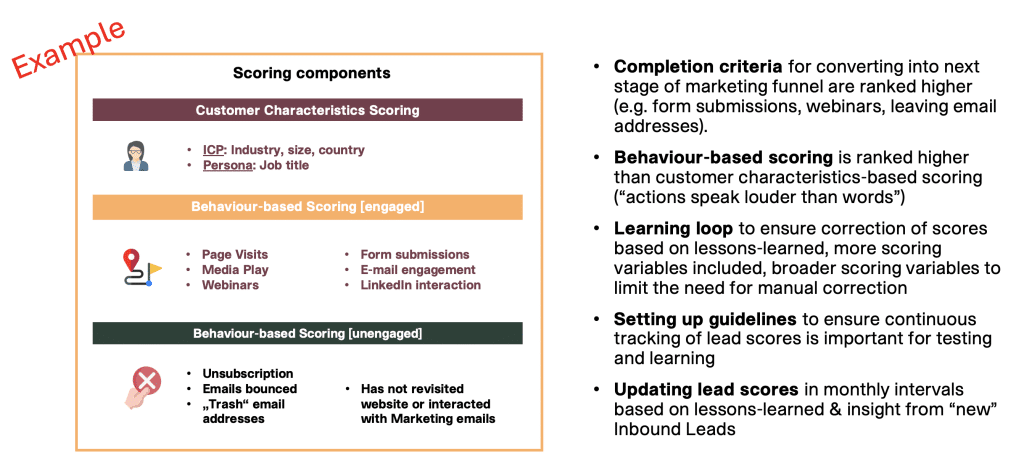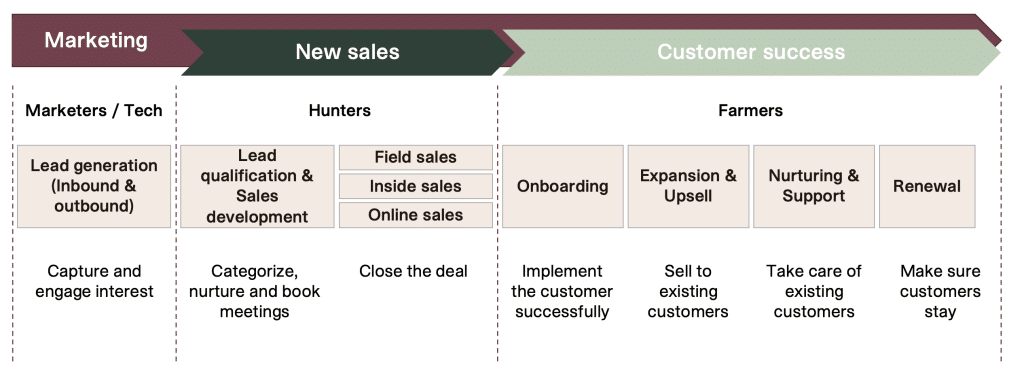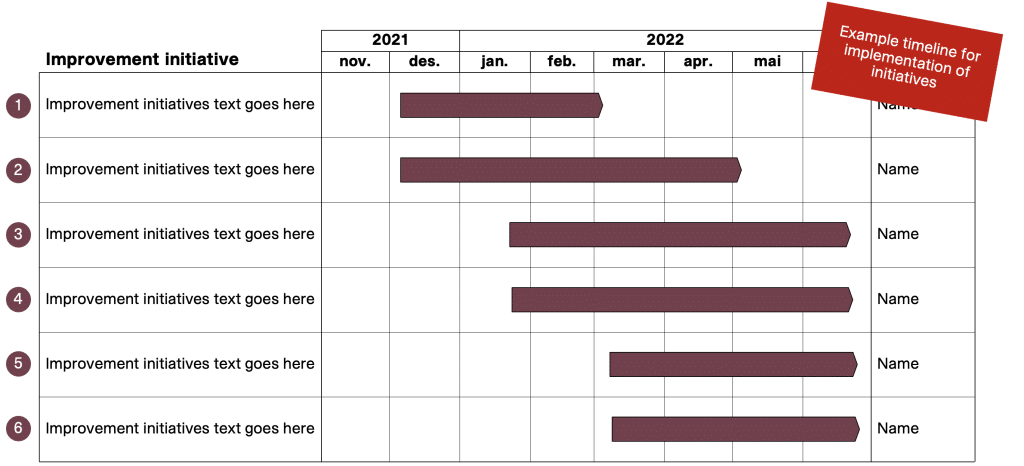How to acquire and win new customers in 2024

Are you a B2B software company looking to attract new customers in 2024? There are a variety of strategies for attracting new customers, including Inbound Marketing. With the right marketing strategy, you can provide your sales department with high-quality leads and increase the chance of closing more deals. Keep reading if you want the insights to succeed with your marketing and sales efforts. No one answer fits all, but the framework can help you prioritize your efforts and set you up for success.
Written by: Christine Karlsen Hammeren, Marketing Manager at Viking Venture
Assess the current situation of your marketing efforts
To know where you should go, you must first understand where you are. Thus, we recommend assessing the current situation to identify any room for improvement. Analyzing your data can be an excellent way to reflect on and document your performance on different KPIs. Do you target the right ideal customer profile (ICP) and personas? Do you know your ICP well enough, and is it known throughout the organization? Are you utilizing the appropriate types of content and channels? And are you working efficiently with sales and customer success to win new customers? What tools can help you automate tasks and improve your win rate? We will elaborate on all of these questions in the following sections. Here are nine steps to help you acquire more new customers in 2024:
- Align your marketing efforts to the overall business goals
- Know your ICP and personas (insights and research)
- Define the process from visitor to closed deal
- Define or refine the marketing content plan
- Channel strategy
- Define the process for nurturing, automation, and lead scoring
- Tools and partners across departments
- Ensure alignment across departments to close more deals
- Project plan for continuous work
1. Align your marketing efforts to the overall business goals
A good starting point for succeeding with your marketing strategy is aligning your marketing efforts with the overall business goals. Let us specify a bit more. The first question to get answered is, what is your company’s target for 2024 in annual recurring revenue (ARR)? When you learn the target, you ask how much of this ARR should come from outbound and inbound sales. Having an ARR target in place, you can use backward engineering to divide it by the average ARR per customer to determine how many new customers you need. Moreover, knowing the number of customers, you can again find how many sales-qualified and marketing-qualified leads you need based on your conversion rates. A data analyst typically runs this task of investigating your customer data thoroughly.
2. Know your ICP and personas
A better understanding of your ICP and personas should help your marketing department target and attract the right audiences. Attracting relevant companies and the decision-makers most likely to invest in your software will help your sales department focus and spend time on high-quality leads, which should increase the sales closing rates. Moreover, these customers are less likely to churn as they fit your offer well.
The customer should always be at the center of your business. Ensure the entire organization understands and agrees on your ICP and personas. Focus on positioning your solution towards the customers differently to create gain or relieve pains. In a previous article, we have explained in more detail how to map your ICP and personas.
3. Define the process from visitor to closed deal
The buyer’s journey visualizes a customer’s experience with your company, from becoming aware of your company to buying your software. The purpose of mapping the buyer’s journey is to understand better the actions, touchpoints, gains, and pain points a customer has throughout the buying process. This understanding will improve your engagement with the customers, and it is critical to increase their gain and reduce their pains most efficiently.
Start by mapping the journey with customer-facing people in the organization. Define the journey across different sales process stages from the customer’s point of view, not just the internal one. The process needs to be reviewed and tested with actual customers. In customer interviews, you should focus on customers’ actions and emotions along the journey, whether they are delighted or frustrated—confused or stressed. An overview of the personas’ experience will help you attach the proper type of content throughout the different stages of their journeys. You can also define your lead scoring at this stage to move the customer down the funnel.
4. Define or refine the content marketing plan
After mapping the target audience and their customer journey, we recommend revisiting your content marketing plan. A review of your content can be helpful to ensure you are addressing your target audience with the right content at the right time throughout their buyer’s journey.
Use the insights from the research and analysis on your ICP and personas together with an SEO analysis. What type of content interests your target audience? What challenges and pain points are they experiencing in their work? Which goals and ambitions do they have in their roles? And what do they look for in a software solution like yours? These are all relevant questions to help prioritize what topics to focus on and what content to create. The SEO analysis will help you to find the search volume and keyword difficulty on the relevant topics. We will not elaborate on SEO in this article but utilizing SEO and topic clusters (external link) can help make your content more visible and drive more traffic to your website.
The insights from mapping the buyer’s journey can help you create pin-pointed content for the awareness, consideration, and decision phases. In general, your content in the awareness stage should speak to symptoms and pains to help buyers understand their problems. At the consideration stage, you inform buyers of possible solutions to their problems. In the decision phase, you help them decide on the right vendor and highlight the value of your solution. However, the mapping will help you create a content plan with clear goals for what, why, when, and whom to target throughout your journey.
Refine your content creation process
Do we have unique and value-driven content to engage our target audience and convert them into leads and loyal customers? Assess your top-performing and low-performing content to analyze what content to do more of and what not to do. Utilize low-hanging fruits by updating and re-purposing the well-performing content.

Your final content plan should include what type of content you are creating, topics, and who is responsible for the different parts of the delivery with deadlines. Write down all steps in creating your content. It could differ depending on the format, like blog posts, videos, eBooks, case studies, webinars, or podcasts. Have clear roles for who is doing what, like strategy, producer, editor, designer, and distribution. One person can have several roles. However, it could be beneficial to have someone quality-assuring the content. If you are working with internal “experts” on specific topics, it is good to have a plan for collaborating to ensure efficient production. You can create the content plan in Excel or a project management tool like Trello, Notion, or Asana. Use whatever works best for you and your team.
5. Channel strategy
When discussing the channel strategy, we distinguish between owned, earned, and paid channels. It would be best to utilize the proper channels for distributing your content depending on what media channels your personas are using and data insights on the different channel’s performance. Focus on doing outstanding in fewer channels rather than trying everything at once.
Owned channels
Your owned media channels are those distribution channels you have control over. It is typically your website, newsletter, and social media accounts. Some companies also have webinars and podcasts. We cannot stress enough how important it is to build a strong website that meets the needs of your ideal customers. There are many considerations regarding the website, including messaging, design and responsiveness, SEO, CTAs, and performance. Proper tracking and analytics will help you improve the page and marketing efforts over time. Essential KPIs to track are conversion rates, traffic, traffic sources, SEO scores, page speed, average time on site, and bounce rate.
Your owned channels are a great way of communicating valuable content to your followers and leads. Moreover, social media channels have broad usage and are one of the most effective free channels for marketing today. Email marketing is a great way to capture leads, follow up, and build relationships with your subscribers.
Paid channels
In our experience, social media marketing and Google ads are the top-performing paid channels for B2B software companies. However, you need to continuously test and analyze how your content is performing to know what works for you. Even though software companies have similar business models, various ICPs and personas consume content and use channels differently. Define a goal for each channel and test multiple organic and paid media with return on investment (ROI) in mind. Keep optimizing your ads for engagement and conversion.
Earned channels
Earned media is the promotion of your brand organically through mentions by others. Getting this form of mentioning or PR can be challenging, but it is often a very effective marketing strategy. Examples of earned media is brand mentioning, PR, guest posts, podcasts or webinars, review sites, communities, SEO, and word-of-mouth. Make a list of what type of media your target audience consumes, what podcasts they listen to, and events they attend and determine where it makes sense for your brand to be visible.
Regardless of your channel strategy, we recommend having clear goals and a common view on how we distribute content aligned with the sales processes. Keep testing and optimizing the channels.
6. Define the process for nurturing, automation, and lead scoring
At this point, you know whom to target, have a content plan in place, and have decided on the channels to utilize for your marketing efforts. Then you should have a good process for capturing leads and nurturing them down the funnel. Lead scoring can help you determine where the leads are in the funnel. Then you can continuously feed content into the proper stages to convert your inbound leads and provide your sales department with warm high-quality leads.
Populate the lead scoring model data with the findings from the ICP and personas characteristics and behavior data. There are several ways to set up your lead scoring model. You can score your leads purely in terms of their interactions and engagement with your content. In this case, you can segment leads based on characteristics in tiers. Another approach is to combine a mix of customer characteristics and behavior, as shown in the example below:

7. Tools and partners across departments
There are numerous solutions on the market for all areas of marketing and sales. Some companies prefer a best-of-breed solution where you choose the best tools to perform a particular task and rely on integrations to link your data. Others prefer a one-in-all solution where you have as much as possible in the same system. Both solutions have pros and cons, and there might be some parts of the customer journey where sales prefer and depend on a CRM system, while marketing prefers another provider for the marketing efforts. However, discussing and evaluating how tools are used across departments to avoid inefficiencies can save time and create better customer experiences.
Secure alignment to nurture leads and customers
You should have a common overview of data, tools, systems, and partners being used across the commercial departments and understand the need for alignment to nurture leads and customers. Relevant questions to ask yourself: are our CRM and marketing tools integrated? How are our tools used today to align processes on data capturing to automate processes and optimize workflows? What are the gains and pains of the different systems and approaches? What are each department’s switching costs and must-haves regarding integration between systems? Running an analysis like this should help you identify how to work more efficiently across commercial departments, provide the optimal plan to win now, and prepare for the future.
8. Ensure alignment across departments to close more deals
The goal for all commercial departments is to contribute to the growth and profitability of the company. Thus, you must ensure alignment across departments to avoid suboptimal behavior and close more deals. In many organizations, there is a gap between the marketing and sales department, which can result in missed opportunities and a disjointed customer experience. To bridge the gap, it’s essential to establish clear communication channels and encourage collaboration between departments. Regular meetings between sales and marketing teams help ensure that messaging and campaigns align with the company’s overall strategy.

9. Project plan for continuous work
Every company has different areas to improve when we run marketing projects with our portfolio. Nevertheless, knowing your strengths and weaknesses helps you make informed decisions instead of guessing or just doing what you always do. The feedback from running these projects has been that taking a step back from running the business as usual and looking into the data to evaluate any room for improvement is valuable. The assessment will result in a project timeline with planned initiatives and the running tasks in prioritized order. The planned initiatives should include the expected gains, the strategic rationale, who is responsible, and the deadlines.
We cannot stress enough how important it is to spend enough time to assess the “as-is” situation because this is how you can truly understand what you could and should do to reach your ARR target. The project plan can be used as a working document to ensure you are delivering on your marketing efforts as planned, and you can adjust the plan as you test and learn what is working.

Get more insights on how to scale your business
Sign up for our newsletter to get valuable insights and the latest perspectives on how Nordic software companies can scale faster. Learn how to improve sales processes, develop your management team, optimize pricing and accelerate through acquisitions.